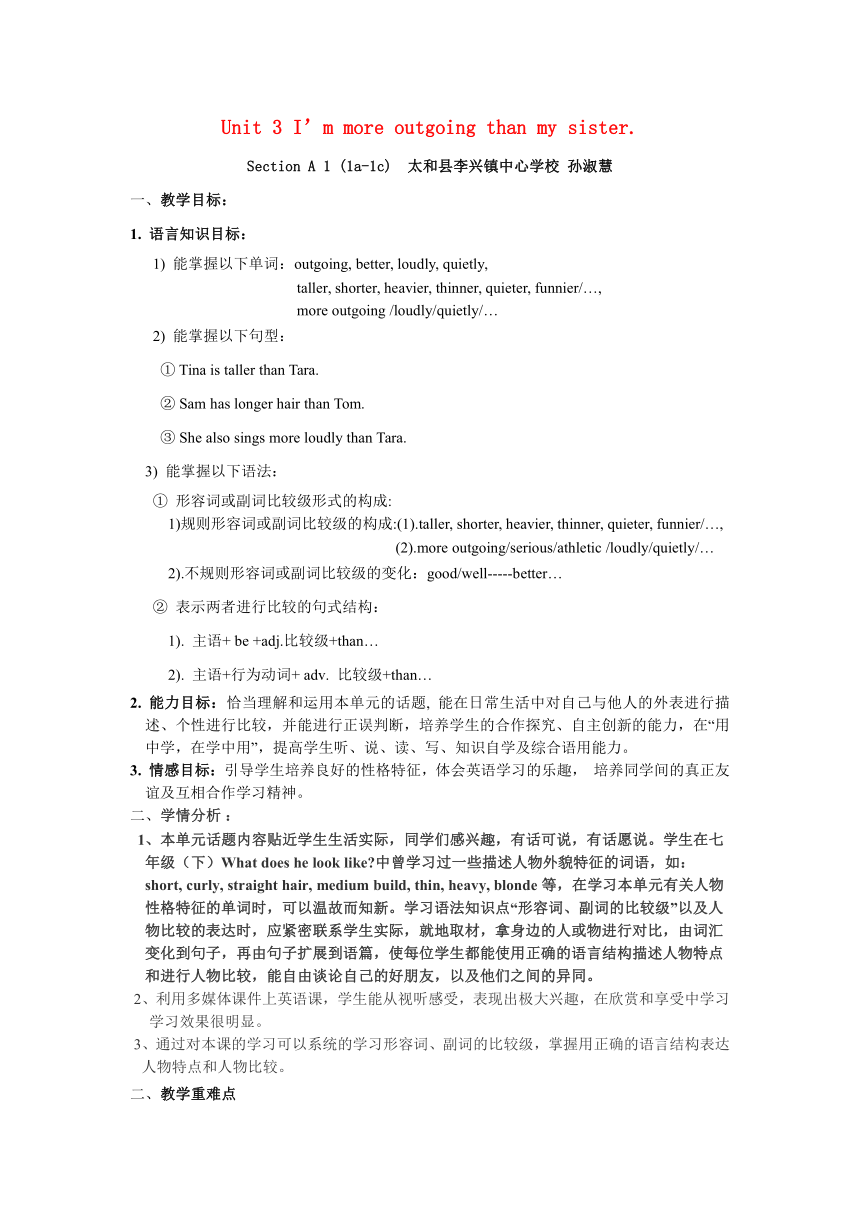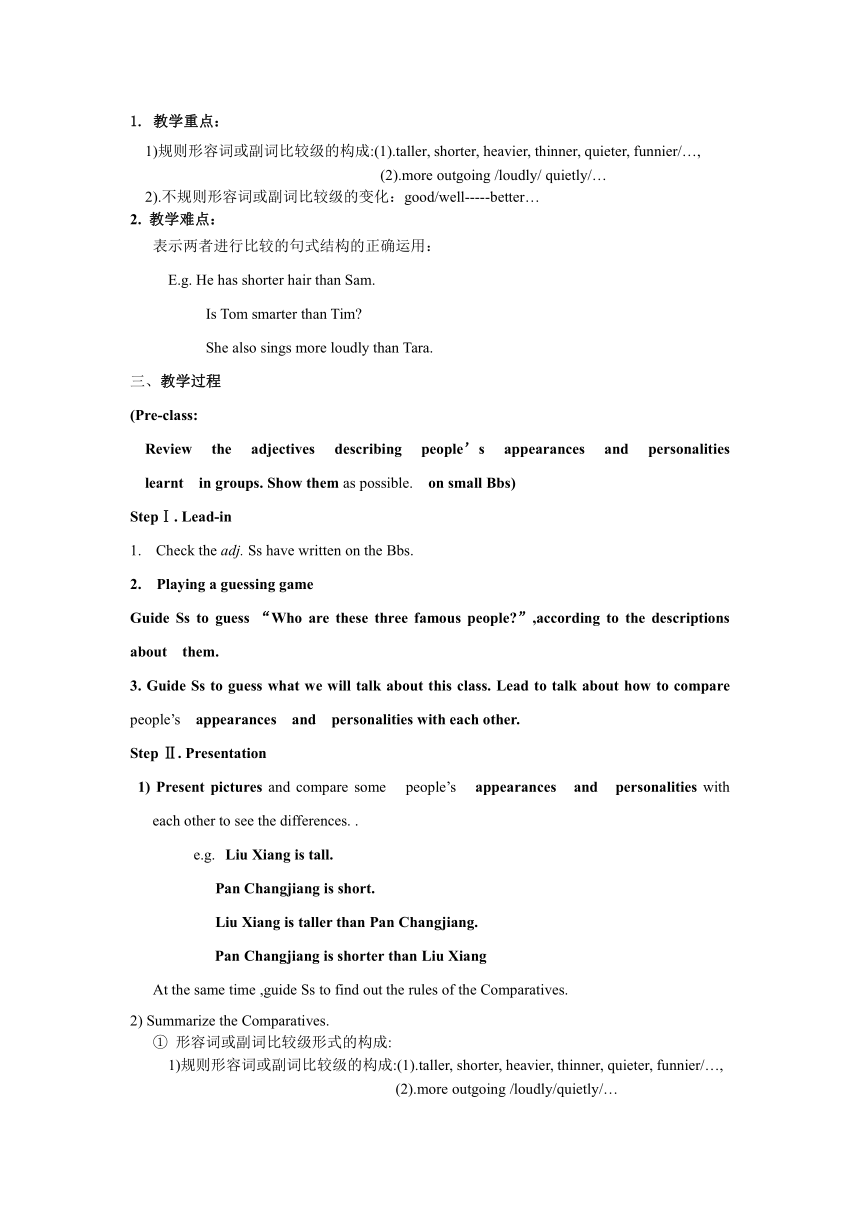Unit 3 I‘m more outgoing than my sister.SectionA(1a-1c)同步教案
文档属性
| 名称 | Unit 3 I‘m more outgoing than my sister.SectionA(1a-1c)同步教案 |  | |
| 格式 | doc | ||
| 文件大小 | 31.0KB | ||
| 资源类型 | 教案 | ||
| 版本资源 | 人教新目标(Go for it)版 | ||
| 科目 | 英语 | ||
| 更新时间 | 2022-06-19 18:52:26 | ||
图片预览


文档简介
Unit 3 I’m more outgoing than my sister.
Section A 1 (1a-1c) 太和县李兴镇中心学校 孙淑慧
一、教学目标:
1. 语言知识目标:
1) 能掌握以下单词:outgoing, better, loudly, quietly,
taller, shorter, heavier, thinner, quieter, funnier/…,
more outgoing /loudly/quietly/…
2) 能掌握以下句型:
① Tina is taller than Tara.
② Sam has longer hair than Tom.
③ She also sings more loudly than Tara.
3) 能掌握以下语法:
① 形容词或副词比较级形式的构成:
1)规则形容词或副词比较级的构成:(1).taller, shorter, heavier, thinner, quieter, funnier/…,
(2).more outgoing/serious/athletic /loudly/quietly/…
2).不规则形容词或副词比较级的变化:good/well-----better…
② 表示两者进行比较的句式结构:
1). 主语+ be +adj.比较级+than…
2). 主语+行为动词+ adv. 比较级+than…
2. 能力目标:恰当理解和运用本单元的话题, 能在日常生活中对自己与他人的外表进行描述、个性进行比较,并能进行正误判断,培养学生的合作探究、自主创新的能力,在“用中学,在学中用”,提高学生听、说、读、写、知识自学及综合语用能力。
3. 情感目标:引导学生培养良好的性格特征,体会英语学习的乐趣, 培养同学间的真正友谊及互相合作学习精神。
二、学情分析 :
1、本单元话题内容贴近学生生活实际,同学们感兴趣,有话可说,有话愿说。学生在七年级(下)What does he look like 中曾学习过一些描述人物外貌特征的词语,如:short, curly, straight hair, medium build, thin, heavy, blonde等,在学习本单元有关人物性格特征的单词时,可以温故而知新。学习语法知识点“形容词、副词的比较级”以及人物比较的表达时,应紧密联系学生实际,就地取材,拿身边的人或物进行对比,由词汇变化到句子,再由句子扩展到语篇,使每位学生都能使用正确的语言结构描述人物特点和进行人物比较,能自由谈论自己的好朋友,以及他们之间的异同。
2、利用多媒体课件上英语课,学生能从视听感受,表现出极大兴趣,在欣赏和享受中学习学习效果很明显。
3、通过对本课的学习可以系统的学习形容词、副词的比较级,掌握用正确的语言结构表达人物特点和人物比较。
二、教学重难点
1. 教学重点:
1)规则形容词或副词比较级的构成:(1).taller, shorter, heavier, thinner, quieter, funnier/…,
(2).more outgoing /loudly/ quietly/…
2).不规则形容词或副词比较级的变化:good/well-----better…
2. 教学难点:
表示两者进行比较的句式结构的正确运用:
E.g. He has shorter hair than Sam.
Is Tom smarter than Tim
She also sings more loudly than Tara.
三、教学过程
(Pre-class: Review the adjectives describing people’s appearances and personalities learnt in groups. Show them as possible. on small Bbs)
StepⅠ. Lead-in
1. Check the adj. Ss have written on the Bbs.
2. Playing a guessing game
Guide Ss to guess “Who are these three famous people ”,according to the descriptions about them.
3. Guide Ss to guess what we will talk about this class. Lead to talk about how to compare people’s appearances and personalities with each other.
Step Ⅱ. Presentation
1) Present pictures and compare some people’s appearances and personalities with each other to see the differences. .
e.g. Liu Xiang is tall.
Pan Changjiang is short.
Liu Xiang is taller than Pan Changjiang.
Pan Changjiang is shorter than Liu Xiang
At the same time ,guide Ss to find out the rules of the Comparatives.
2) Summarize the Comparatives.
① 形容词或副词比较级形式的构成:
1)规则形容词或副词比较级的构成:(1).taller, shorter, heavier, thinner, quieter, funnier/…,
(2).more outgoing /loudly/quietly/…
2).不规则形容词或副词比较级的变化:good/well-----better…展示不规则形容词或副词比较级的变化表
② 表示两者进行比较的句式结构:
(1) A(主语) + be (V) + adj. 比较级 + than + B.
(2) A (主语) + 行为动词(V) + adv.比较级 + than + B.
Step Ⅲ 1a Match each word with its opposite
Ask students to do this activity individually. Then check and answers.
tall—short thin—heavy long hair—short hair quietly--loudly
Step Ⅳ. 1b Listening
Then listen to the recording. Ask Ss to number the twins.
Check the answers.
Step Ⅴ. Pair work
Guide Ss to work with a partner. Make your own conversation about the twins, like the sample conversation in 1c.
Ask several pairs to show one or more of their conversations.
Step Ⅵ .Oral practice
Ask Ss to compare with their partners and find out the differences.
e.g. She is heavier than me. I am more outgoing than her.
She gets up earlier than me. I run faster than her.
Then let some pairs act out their conversations in front of the class.
Homework:
Write six sentences:
about different appearances and personalities between you and your best friend.
板书设计:
Reflection:
Unit 3 Section A (1a-1c)
单词: outgoing, better, loudly, quietly,
taller, shorter, heavier, thinner, quieter, funnier/…,
. more outgoing /loudly/quietly/…
句型:① Tina is taller than Tara.
② Sam has longer hair than Tom.
③ She also sings more loudly than Tara.
Section A 1 (1a-1c) 太和县李兴镇中心学校 孙淑慧
一、教学目标:
1. 语言知识目标:
1) 能掌握以下单词:outgoing, better, loudly, quietly,
taller, shorter, heavier, thinner, quieter, funnier/…,
more outgoing /loudly/quietly/…
2) 能掌握以下句型:
① Tina is taller than Tara.
② Sam has longer hair than Tom.
③ She also sings more loudly than Tara.
3) 能掌握以下语法:
① 形容词或副词比较级形式的构成:
1)规则形容词或副词比较级的构成:(1).taller, shorter, heavier, thinner, quieter, funnier/…,
(2).more outgoing/serious/athletic /loudly/quietly/…
2).不规则形容词或副词比较级的变化:good/well-----better…
② 表示两者进行比较的句式结构:
1). 主语+ be +adj.比较级+than…
2). 主语+行为动词+ adv. 比较级+than…
2. 能力目标:恰当理解和运用本单元的话题, 能在日常生活中对自己与他人的外表进行描述、个性进行比较,并能进行正误判断,培养学生的合作探究、自主创新的能力,在“用中学,在学中用”,提高学生听、说、读、写、知识自学及综合语用能力。
3. 情感目标:引导学生培养良好的性格特征,体会英语学习的乐趣, 培养同学间的真正友谊及互相合作学习精神。
二、学情分析 :
1、本单元话题内容贴近学生生活实际,同学们感兴趣,有话可说,有话愿说。学生在七年级(下)What does he look like 中曾学习过一些描述人物外貌特征的词语,如:short, curly, straight hair, medium build, thin, heavy, blonde等,在学习本单元有关人物性格特征的单词时,可以温故而知新。学习语法知识点“形容词、副词的比较级”以及人物比较的表达时,应紧密联系学生实际,就地取材,拿身边的人或物进行对比,由词汇变化到句子,再由句子扩展到语篇,使每位学生都能使用正确的语言结构描述人物特点和进行人物比较,能自由谈论自己的好朋友,以及他们之间的异同。
2、利用多媒体课件上英语课,学生能从视听感受,表现出极大兴趣,在欣赏和享受中学习学习效果很明显。
3、通过对本课的学习可以系统的学习形容词、副词的比较级,掌握用正确的语言结构表达人物特点和人物比较。
二、教学重难点
1. 教学重点:
1)规则形容词或副词比较级的构成:(1).taller, shorter, heavier, thinner, quieter, funnier/…,
(2).more outgoing /loudly/ quietly/…
2).不规则形容词或副词比较级的变化:good/well-----better…
2. 教学难点:
表示两者进行比较的句式结构的正确运用:
E.g. He has shorter hair than Sam.
Is Tom smarter than Tim
She also sings more loudly than Tara.
三、教学过程
(Pre-class: Review the adjectives describing people’s appearances and personalities learnt in groups. Show them as possible. on small Bbs)
StepⅠ. Lead-in
1. Check the adj. Ss have written on the Bbs.
2. Playing a guessing game
Guide Ss to guess “Who are these three famous people ”,according to the descriptions about them.
3. Guide Ss to guess what we will talk about this class. Lead to talk about how to compare people’s appearances and personalities with each other.
Step Ⅱ. Presentation
1) Present pictures and compare some people’s appearances and personalities with each other to see the differences. .
e.g. Liu Xiang is tall.
Pan Changjiang is short.
Liu Xiang is taller than Pan Changjiang.
Pan Changjiang is shorter than Liu Xiang
At the same time ,guide Ss to find out the rules of the Comparatives.
2) Summarize the Comparatives.
① 形容词或副词比较级形式的构成:
1)规则形容词或副词比较级的构成:(1).taller, shorter, heavier, thinner, quieter, funnier/…,
(2).more outgoing /loudly/quietly/…
2).不规则形容词或副词比较级的变化:good/well-----better…展示不规则形容词或副词比较级的变化表
② 表示两者进行比较的句式结构:
(1) A(主语) + be (V) + adj. 比较级 + than + B.
(2) A (主语) + 行为动词(V) + adv.比较级 + than + B.
Step Ⅲ 1a Match each word with its opposite
Ask students to do this activity individually. Then check and answers.
tall—short thin—heavy long hair—short hair quietly--loudly
Step Ⅳ. 1b Listening
Then listen to the recording. Ask Ss to number the twins.
Check the answers.
Step Ⅴ. Pair work
Guide Ss to work with a partner. Make your own conversation about the twins, like the sample conversation in 1c.
Ask several pairs to show one or more of their conversations.
Step Ⅵ .Oral practice
Ask Ss to compare with their partners and find out the differences.
e.g. She is heavier than me. I am more outgoing than her.
She gets up earlier than me. I run faster than her.
Then let some pairs act out their conversations in front of the class.
Homework:
Write six sentences:
about different appearances and personalities between you and your best friend.
板书设计:
Reflection:
Unit 3 Section A (1a-1c)
单词: outgoing, better, loudly, quietly,
taller, shorter, heavier, thinner, quieter, funnier/…,
. more outgoing /loudly/quietly/…
句型:① Tina is taller than Tara.
② Sam has longer hair than Tom.
③ She also sings more loudly than Tara.
同课章节目录
- Unit 1 Where did you go on vacation?
- Section A
- Section B
- Unit 2 How often do you exercise?
- Section A
- Section B
- Unit 3 I'm more outgoing than my sister.
- Section A
- Section B
- Unit 4 What's the best movie theater?
- Section A
- Section B
- Unit 5 Do you want to watch a game show?
- Section A
- Section B
- Unit 6 I'm going to study computer science.
- Section A
- Section B
- Unit 7 Will people have robots?
- Section A
- Section B
- Unit 8 How do you make a banana milk shake?
- Section A
- Section B
- Unit 9 Can you come to my party?
- Section A
- Section B
- Unit 10 If you go to the party, you'll have a grea
- Section A
- Section B
